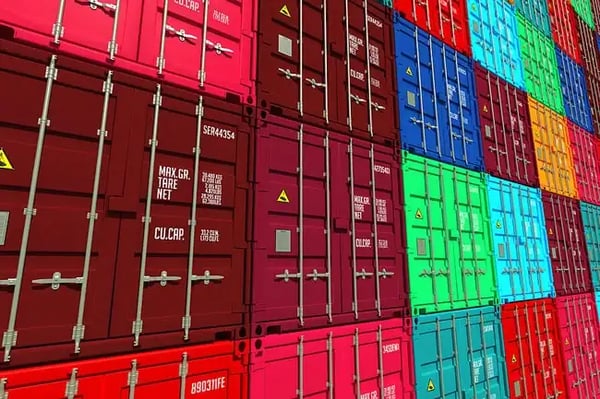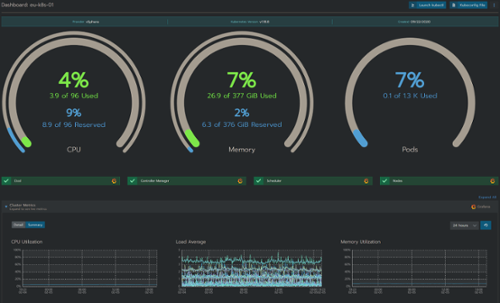Get Migrating Quickly With EVComplete
There are many reasons that make it a super quick process to migrate with EVComplete. This blog compares Cloudficient's method to traditional...
At Cloudficient, we build the future of business. We have helped many enterprise-level organizations efficiently handle ...
At Cloudficient, we build the future of business. We have helped many enterprise-level organizations efficiently handle some of the most complex operational transitions you can imagine.
Our goal is to help our clients thrive, not just survive through a major change. That's why it makes perfect sense that we use Kubernetes.
Kubernetes (in short K8s) is a core element of cloud-native infrastructure. It serves as the foundation for our products and services. It ticks all of the right boxes:
The K8s method is in direct contrast to non-containerized applications. In the traditional business computing model, each operation ran on its own hardware. The first move to cloud was mostly dominated by monolith, over-resourced virtual machines (VMs). Due mostly to high up-front capital requirements, operational inefficiency or a combination of the two, neither of these models turned out to be completely scalable.
Containers made things more efficient, but they made a multi-headed mess in the process. Kubernetes changed containers, making complex resource management and deployment strategies possible at scale.
This article is mostly for hands-on IT leaders, sys admins, DevOps professionals and private consultants. We'll assume you have a level of familiarity with the concepts behind containerized applications, but — just to be safe — we will start with a brief look at what K8s is and what it does.
The Kubernetes Landscape
You can go straight to the Kubernetes project page for an overview of features, whitepapers, training and so on. One of the first things you'll see is that K8s is a major open-source project with almost universal tech-industry support.
Everyone from Amazon to Zendesk is involved in the project in some way. That type of support and adoption proves just how useful and adaptable this tool is.
What Kubernetes Does

Moving on to the documentation section, we have the main definition. "Kubernetes is an open source container orchestration engine for automating deployment, scaling, and management of containerized applications."
The key word is "orchestration" – Kubernetes shines when operational efficiency goals necessitate taking many moving parts and making them all work in harmony. It allows centralized control, a predetermined plan and total modularity. Think of it as a composer conducts a symphony orchestra.
Here are a few of the things that K8s can do:
Global Operational Scale with Small Teams
We already have the option to cheaply run a single process on its own micro-OS over bare metal, emulate different operating environments without reconfiguration and so on. It's hardly news that granular microservices are possible through the use of containers. In other words, we've had the hardware and software sides of the efficiency problem solved for a while now.
K8s solves the human side as well. A single admin can run a Kubernetes cluster of basically any size. A few small teams can run (that is administrate, report on and deploy) everything necessary to power the computing needs of a complex, worldwide enterprise.
Modular Reusability and Automatic Management
Docker containers can be deployed from a central repository with minimal configuration. In a similar way, K8s can take complex operations and transplant them to different environments.
Just like an admin can change the parameters of a program running in a container, an admin can change the behaviors and buildouts of containers running in K8s. The modularity allows organizations to act on changing conditions, regional requirements, testing results from other clusters and so on.
Another essential advantage of modularity is stability. Not only can nodes be duplicated and redeployed elsewhere, but the containers within them can also be automatically substituted on failure. Even entire master nodes can be automatically swapped in and out to support mission-critical processes. Similarly, Kubernetes can provision computing resources on an as-needed basis to applications with highly variable demand, for example by committing many parallel duplicate microservice instances to heavy tasks.
Smart Persistence-Store Usage
 Just like data in NoSQL databases isn't always locked into tidy lists, business operations' data requirements don't always fit into the NoSQL or SQL category. However, with K8s, we get a level of control over organization that often lets us optimize even the most stubbornly ambiguous applications.
Just like data in NoSQL databases isn't always locked into tidy lists, business operations' data requirements don't always fit into the NoSQL or SQL category. However, with K8s, we get a level of control over organization that often lets us optimize even the most stubbornly ambiguous applications.
K8s can organize stacks of microservices basically as high or as wide as necessary, simulating any structure on a single machine or across hybrid environments. That means enterprise-level organizations can (and many do) operate a handful of huge VMs per global region, using K8s to stack vertically-scaling data stores next to large horizontal pools of microservice instances.
The beauty of a cluster of containers (i.e., Kubernetes) is that it allows ultimate adaptability. Organizations can run what they want, choose which persistence store is best for each use case and handle even rapidly emerging demands with minimal friction. Additionally, we can use it to integrate across platforms and providers due to the minute level of modularity.
Cloud-Provider Agnostic
It might seem like a footnote at this point, but one of the most important elements of Kubernetes is that it's not proprietary. It's an open-source project that works on (or has certified projects with full native API compatibility with) AWS, Azure, Google, IBM, Baidu, Tencent, IONOS, DigitalOcean and other major providers. It provides the worldwide platform options that we and our customers need.
Simply Essential for Cloud

Clustering is not the only possible cloud computing structure, but it is one of the most powerful, scalable and adaptable options available. We need those advantages to provide the “cloudficiency” that our clients, from small to large enterprises, expect from a migration and cloud consulting firm.
We can test changes instantly, even during production. We can rapidly scale solutions across the globe. We can do it all with the most efficient use of our back-end resources possible. All of that allows us to be highly competitive in terms of quality and speed. That is why we use containerized microservices running in Kubernetes clusters as the foundation for our products.
Would you like to see how our system scales to your challenges? Get started with our risk-free trial, contact us to discuss your project, overcome challenges or ask questions. You can call our European or American offices or send an email to info@cloudficient.com.
There are many reasons that make it a super quick process to migrate with EVComplete. This blog compares Cloudficient's method to traditional...
Find out how easy it is to migrate from Enterprise Vault to Office 365 using Cloudficient as your migration partner.
If you're part of a large company you may struggle to process, track, report-on and audit your onboarding activities. Find out about a better way!